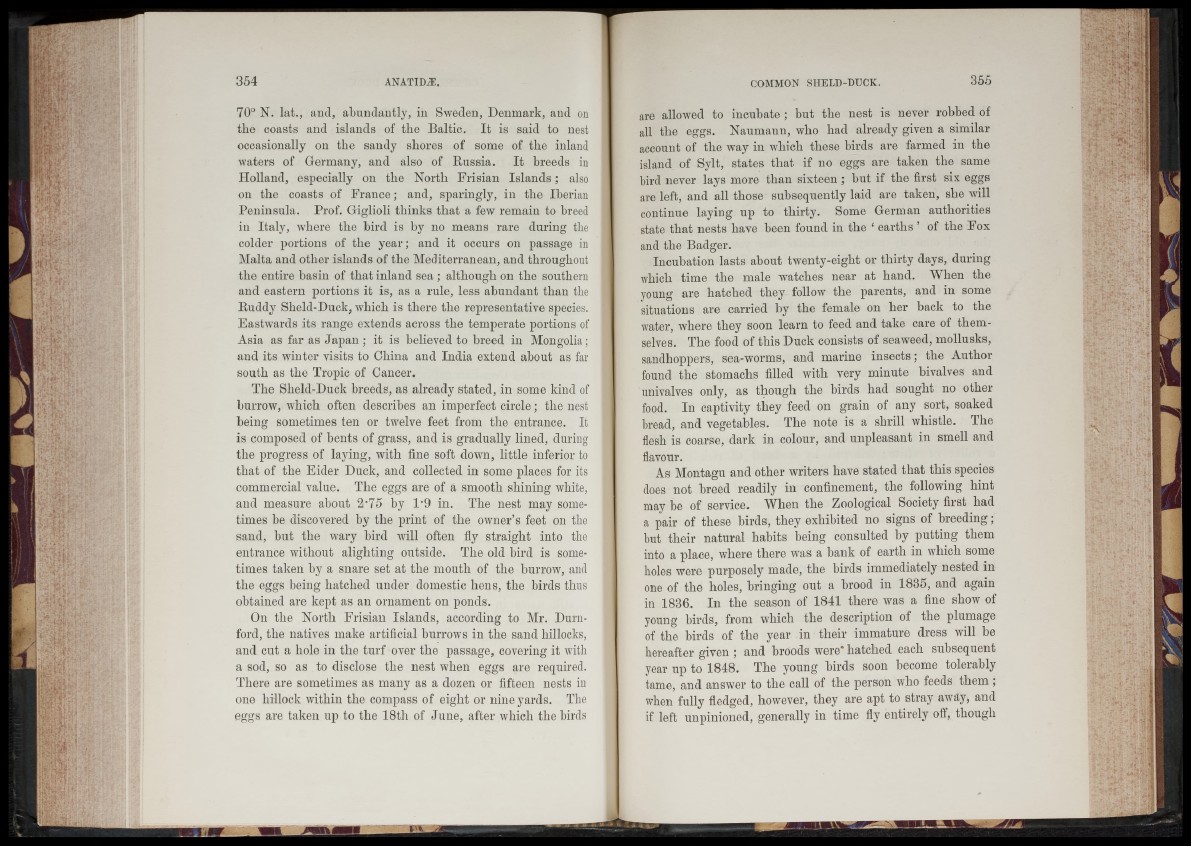
70° N. lat., and, abundantly, in Sweden, Denmark, and on
the coasts and islands of the Baltic. It is said to nest
occasionally on the sandy shores of some of the inland
waters of Germany, and also of Russia. It breeds in
Holland, especially on the North Frisian Islands; also
on the coasts of France; and, sparingly, in the Iberian
Peninsula. Prof. Giglioli thinks that a few remain to breed
in Italy, where the bird is by no means rare during the
colder portions of the year; and it occurs on passage in
Malta and other islands of the Mediterranean, and throughout
the entire basin of that inland sea ; although on the southern
and eastern portions it is, as a rule, less abundant than the
Ruddy Sheld-Duck, which is there the representative species.
Eastwards its range extends across the temperate portions of
Asia as far as Japan ; it is believed to breed in Mongolia;
and its winter visits to China and India extend about as far
south as the Tropic of Cancer.
The Sheld-Duck breeds, as already stated, in some kind of
burrow, which often describes an imperfect circle; the nest
being sometimes ten or twelve feet from the entrance. It
is composed of bents of grass, and is gradually lined, during
the progress of laying, with fine soft down, little inferior to
that of the Eider Duck, and collected in some places for its
commercial value. The eggs are of a smooth shining white,
and measure about 2-75 by 1*9 in. The nest may sometimes
be discovered by the print of the owner’s feet on the
sand, but the wary bird will often fly straight into the
entrance without alighting outside. The old bird is sometimes
taken by a snare set at the mouth of the burrow, and
the eggs being hatched under domestic hens, the birds thus
obtained are kept as an ornament on ponds.
On the North Frisian Islands, according to Mr. Durn-
ford, the natives make artificial burrows in the sand hillocks,
and cut a hole in the turf over the passage, covering it with
a sod, so as to disclose the nest when eggs are required.
There are sometimes as many as a dozen or fifteen nests in
one hillock within the compass of eight or nine yards. The
eggs are taken up to the 18th of June, after which the birds
are allowed to incubate ; but the nest is never robbed of
all the eggs. Naumann, who had already given a similar
account of the way in which these birds are farmed in the
island of Sylt, states that if no eggs are taken the same
bird never lays more than sixteen ; but if the first six eggs
are left, and all those subsequently laid are taken, she will
continue laying up to thirty. Some German authorities
state that nests have been found in the £ earths ’ of the Fox
and the Badger.
Incubation lasts about twenty-eight or thirty days, during
which time the male watches near at hand. When the
young are hatched they follow the parents, and in some
situations are carried by the female on her back to the
water, where they soon learn to feed and take care of themselves.
The food of this Duck consists of seaweed, mollusks,
sandhoppers, sea-worms, and marine insects; the Author
found the stomachs filled with very minute bivalves and
univalves only, as though the birds had sought no other
food. In captivity they feed on grain of any sort, soaked
bread, and vegetables. The note is a shrill whistle. The
flesh is coarse, dark in colour, and unpleasant in smell and
flavour.
As Montagu and other writers have stated that this species
does not breed readily in confinement, the following hint
may be of service. WRen the Zoological Society first had
a pair of these birds, they exhibited no signs of breeding;
but their natural habits being consulted by putting them
into a place, where there was a bank of earth in which some
holes were purposely made, the birds immediately nested in
one of the holes, bringing out a brood in 1835, and again
in 1836. In the season of 1841 there was a fine show of
young birds, from which the description of the plumage
of the birds of the year in their immature dress will be
hereafter given ; and broods were* hatched each subsequent
year up to 1848. The young birds soon become tolerably
tame, and answer to the call of the person who feeds them ;
when fully fledged, however, they are apt to stray away, and
if left unpinioned, generally in time fly entirely off, though